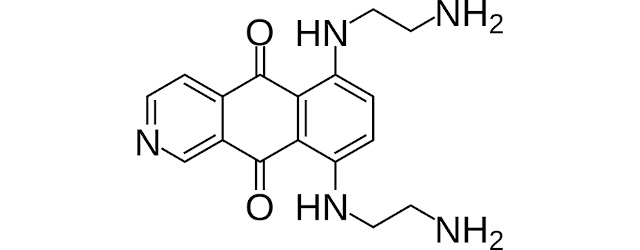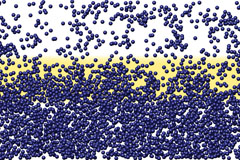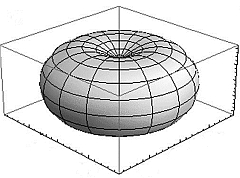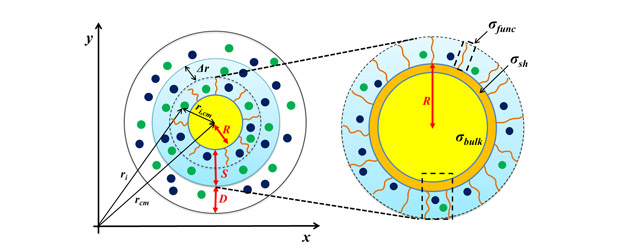Activity–driven fluctuations in living cells (Vol. 46 No. 5-6)
 Mean square displacement of tracers in living cells
Mean square displacement of tracers in living cells
Living cells operate far from equilibrium due to the permanent injection of energy provided by ATP supply. The dynamics of the intracellular components is driven by both thermal equilibrium fluctuations, and active stochastic forces generated by the molecular motors.
To sort out genuine nonequilibrium fluctuations from purely thermal effects, we inject tracer particles in ATP depleted cells. By testing the fluctuation-dissipation theorem (FDT), we identify these cells as an equilibrium-like reference in which the tracers remain locally confined by the elastic cytoskeletal network that permeates the cytoplasm. In contrast, we highlight a violation of the FDT and a diffusion-like motion at long time scales in untreated and selective motor inhibited cells. Removing the thermal contribution in the tracer fluctuations, we estimate the spectrum of the active forces. Eventually, we report non-Gaussian tails in the tracer displacement distribution as a result of directed motion events.
We recapitulate theoretically the observed fluctuations by modeling the dynamics with a con- fining harmonic potential which experiences random bursts as a result of motor activity. This minimal model allows us to quantify the time scales of the active forces, along with the energy injected by the ensuing fluctuations.
E. Fodor, M. Guo, N. S. Gov, P. Visco, D. A. Weitz and F. van Wijland, Activity-driven fluctuations in living cells, EPL, 110, 48005 (2015)
[Abstract]
Adhesion disturbed by noise (Vol. 44 No. 2)
 Schematic illustrations of the pining and de-pinning events of the fibrils in contact with a rigid sphere.
Schematic illustrations of the pining and de-pinning events of the fibrils in contact with a rigid sphere.
A new model that could ultimately help robotic fingers made of a soft surface manipulate small objects is based on an understanding of how a ball stops adhering to a soft surface and starts rolling.
Imagine a solid ball rolling down a slightly inclined ramp. What could be perceived as child’s play is here the focus of a serious theoretical work. The present study has one thing in common with childhood behaviour, it introduces a mischievous idea, namely studying the effect of random noise, such as vibrations, on the ball. It shows that it could lower the energy barrier to set the ball in motion.
The authors used a ramp with a micro‐textured surface. This surface is akin to that of the gecko’s feet, made of so-called microfibrils capable of adhering to any surface by elastical deformation. They then studied the effect of vibration on a ball left on the top of such a textured ramp by subjecting it to a computer generated random vibration.
The model shows that an activation energy is required to start the ball moving. It has been long known that the same applies to the adhesion of molecules, on a much smaller scale, as predicted theoretically by the so-called Arrhenius kinetics. This study pinpoints a finite threshold of intensity for the vibration noise above which the ball starts rolling.
These findings could have implications, for example, for new MicroElectroMechanical systems (MEMs) based on robotic fingers that would be capable of displacing a small object and could be assisted by noise.
M.K. Chaudhury and P.S. Goohpattader, ‘Noise activated dissociation of soft elastic contacts’, Eur. Phys. J. E 35, 131 (2012)
[Abstract]
Adjustable adhesion power: what fakirs can learn from geckos (Vol. 47 No. 2)

New study models adhesion force as key to contact between two rough, yet elastic, surfaces
The authors have now developed a model to study the importance of adhesion in establishing contact between two patterned, yet elastic, surfaces. Nature is full of examples of amazing adjustable adhesion power, like the feet of geckos, covered in multiple hairs of decreasing size. Until now, most experimental and theoretical studies have only focused on the elastic deformation of surfaces, neglecting the adhesion forces between such surfaces. This new approach just published, matters when the scale of adhesive forces, is comparable to elastic forces on materials such as tyres. What the authors focused on was the transition between what they describe as the “happy fakir” scenario, where the sphere hardly presses against the pillars, and the “impaled fakir” scenario, where there is a strong adhesion between the two surfaces. By comparing experimental data on the size of the contact area--which gives rise to the so-called van der Waals cohesive forces between the molecules--with the findings of their new theoretical model, they revealed the importance of adhesion between the two different surfaces in establishing contact.
L. Dies, F. Restagno, R. Weil, L. Léger and C. Poulard, Role of adhesion between asperities in the formation of elastic solid/solid contacts, Eur. Phys. J. E 38, 130 (2015)
[Abstract]
Advanced cancer drug shrinks and intercalates DNA (Vol. 51, No. 1)

Experiments and statistical models reveal that the recently developed cancer drug Pixantrone forces itself inside the double helix structure of DNA molecules, then shrinks their backbones.
Because of the harmful side-effects of chemotherapy, and the increasing resistance to drugs found in many cancer cells, it is critical for researchers to continually search for new ways to update current cancer treatments. Recently, a drug named Pixantrone (PIX) was developed, which is far less damaging to the heart than previous, less advanced compounds. PIX is now used to treat cancers including non-Hodgkin’s lymphoma and leukaemia, but a detailed knowledge of the molecular processes it uses to destroy cancer cells has been lacking so far. In a new study published in EPJ E, Marcio Rocha and colleagues at the Federal University of Viçosa in Brazil uncovered the molecular mechanisms involved in PIX’s interactions with cancer DNA in precise detail. They found that the drug first forces itself between the strands of the DNA molecule’s double helix, prising them apart; then compacts the structures by partially neutralising their phosphate backbones.
C.H.M. Lima, J.M. Caquito jr, R.M. de Oliveira, M.S. Rocha, Pixantrone anticancer drug as a DNA ligand: Depicting the mechanism of action at single molecule level, Eur. Phys. J. E 42, 130 (2019)
[Abstract]
Advanced simulations shed light on fluid interfaces (Vol. 46 No. 3)

Any piece of liquid matter requires confinement by solid or fluid boundaries. The simplest case is the interface between liquid and its corresponding vapour. This is subject of ongoing research, pioneered by the Dutch physicist van der Waals 120 years ago. One long-standing problem is about the surface tension at the nanometre scale, for which theory and experiments suggest a high length-scale sensitivity. However, various previous computer simulations found little evidence for this and reached contradictory conclusions.
In this work the authors re-open the case and present a fresh view on fluid interfaces by combining high-performance simulations with proposing a new way of analysing X-ray scattering (GISAXS) experiments. They discover an unexpected dependence of the surface tension on temperature and wavelength, with possibly far-reaching implications for nanoparticle probes, wetting films, and droplet nucleation. The new insight was achieved by utilising novel accelerator hardware, which provides an energy-efficient platform for massively parallel computing and boosts the new supercomputer “Hydra” of the Max Planck Society.
F. Höfling and S. Dietrich, Enhanced wavelength-dependent surface tension of liquid-vapour interfaces, EPL, 109, 46002 (2015)
[Abstract]
Advances in positron-molecule annihilation physics (Vol. 45 No. 1)
The interactions of positrons with atoms and molecules are important in diverse settings, from applications in materials science to understanding the origin of the positron-electron annihilation gamma-ray line emanating from the centre of our galaxy. Furthermore, there are important applications in Positron Emission Tomography.
A vital parameter is termed Zeff, the effective number of electrons available to the positron for annihilation. This quantity is almost always greater than the actual number of electrons, Z, due to the dominant electron-positron attraction. Careful measurements of the gas density dependence of the positron annihilation rate were performed for a number of species. By incorporating corrections for non-linearities due to many-body interactions, accurate values of Zeff for N2, O2, CO, N2O and CH4 were derived. It is hoped that this work will serve to benchmark the positron annihilation rates in these molecules and act as a spur to further theoretical development in positron-molecule scattering.
M. Charlton, T. Giles, H. Lewis and D.P. van der Werf, “Positron annihilation in small molecules” J. Phys. B: At. Mol. Opt. Phys. 46, 195001 (2013)
[Abstract]
Advancing AGATA – Future Science with The Advanced Gamma Tracking Array (Vol. 51, No. 4)

The Advanced Gamma Tracking Array is a multi-national European project realising a high-resolution gamma-ray spectrometer for nuclear physics.
As a travelling detector AGATA will be employed at the major European research facilities delivering stable and radioactive ion beams. It will have a large impact on nuclear structure studies at the extremes of isospin, mass, angular momentum, excitation energy and temperature. AGATA is capable of measuring γ rays from a few tens of keV to beyond 10 MeV, with high angular resolution and high count-rate capabilities. This review describes the exciting science program to be performed with AGATA enabling us to uncover and understand hitherto hidden secrets of the atomic nucleus.
The AGATA Collaboration, W. Korten et al., Eur. Phys. J. A 56, 137 (2020)
[Abstract]
All paths lead to Rome, even in condensed matter theory (Vol. 45 No.3)
 Carlo Di Castro
Carlo Di Castro
The author shares his thoughts on the development of theoretical condensed matter physics in Rome from the 1960s until the beginning of this century.
This work presents his recollections of how theoretical condensed matter physics developed in Rome, starting in the 1960s. This was done in an interview in which the author reflects upon his research career.
He presents a unique, personal account of the evolution of these research fields since the 1960s. He relates the encounters he had with those who would go on to become the next generation of condensed matter physicists and explains his involvement in setting up the ‘Rome Group’, an authority in his field, together with other members.
C. Di Castro and L. Bonolis, “Personal remembrances of the beginnings of theoretical condensed matter physics in Rome”, Eur. Phys. J. H, 39, 3 (2014)
[Abstract]
All-optical production and trapping of metastable noble gas atoms down to the single atom regime (Vol. 46 No. 1)

The determination of isotope ratios of noble gases has many applications e.g. in physics, nuclear arms control and earth sciences. In many cases, low concentrations of wanted noble gas isotopes (e.g. Kr and Ar in air or groundwater samples) make single atom detection necessary to achieve an adequate precision of measurement. As an important step into this direction, we demonstrate operation of an Atom Trap Trace Analysis (ATTA) setup based on a magneto-optical trap (MOT) for metastable Kr atoms excited by all-optical means. Compared to other state-of-the-art techniques for preparing metastable noble gas atoms, all-optical production is capable of overcoming limitations regarding minimal sample volume and avoiding cross-contamination. In addition, it allows for a compact and reliable setup. We identify optimal parameters of our experimental setup by employing the most abundant isotope Kr-84, and demonstrate single atom detection within a 3D MOT.
M. Kohler et al., “All-optical production and trapping of metastable noble-gas atoms down to the single-atom regime”, EPL 108, 13001 (2014)
[Abstract]
Analogue quantum computers: still wishful thinking? (Vol. 46 No. 2)

Many challenges lie ahead before quantum annealing, the analogue version of quantum computation, contributes to solve combinatorial optimisation problems
Traditional computational tools are simply not powerful enough to solve some complex optimisation problems, like, for example, protein folding. Quantum annealing, a potentially successful implementation of analogue quantum computing, would bring about an ultra-performant computational method. A series of reviews guest-edited by the authors, focuses on the state of the art and challenges in quantum annealing. This approach, if proven viable, could greatly boost the capabilities of large-scale simulations and revolutionise several research fields, from biology to economics, medicine and material science.
A company called D-Wave has been commercialising what it claims are quantum annealers, since 2011. There have been speculations from the science community as to whether the D-Wave technology actually delivers quantum annealing. “The reviews of our latest issue show that the performances of the D-Wave machines as quantum computers, while noteworthy, have remained essentially inconclusive,” explain the authors.
S. Suzuki and A. Das, “Quo Vadis quantum annealing?, Eur. Phys. J. Special Topics 224, 5 (2015)
[Abstract]
A. Das and S. Suzuki,, “Debate and discussion: Quo Vadis quantum annealing?”, Eur. Phys. J. Special Topics 224, 205 (2015)
[Abstract]
Analysing Coulomb-excitation experiments with exotic beams (Vol. 47 No. 3)

This paper presents a number of novel and alternative analysis techniques to extract transition strengths and quadrupole moments from Coulomb excitation data with Radioactive Ion Beams (RIBs) using the GOSIA code. It is anticipated that related approaches and techniques will gain an even greater importance as a wider range of post-accelerated RIBs becomes available at the next generation of ISOL facilities.
Indeed, recent advances in RIB technology, in particular the increasing range of species and post-acceleration energies available from ISOL facilities, have led to a resurgence of the use of nuclear reactions to study the structure of nuclei. Specifically, Coulomb excitation at safe energies, where the surfaces of the colliding nuclei are kept apart (typically 2-5 MeV/A), is now giving unrivalled information on the electromagnetic properties of exotic nuclei, leading to knowledge of the nuclear shape or, more precisely, the charge distribution of individual states. The usefulness of the technique to extract key nuclear-structure information has been demonstrated since the 1960's with stable beam and target combinations.
The paper addresses the situation where new challenges present themselves when studying exotic nuclei, including dealing with low statistics or number of data points, absolute and relative normalization of the measured cross sections and a lack of complementary experimental data, such as excited-state lifetimes, mixing and branching ratios.
M. Zielińska + 9 co-authors, Analysis methods of safe Coulomb-excitation experiments with
radioactive ion beams using the GOSIA code, Eur. Phys. J. A 52, 99 (2016)
[Abstract]
Analysis of dynamic nano-scale interactions (Vol. 43 No. 2)
 (a) Topographic and (b) phase contrast images of a carbon nanotube grown on a quartz surface. (c) Viscous and hysteretic dissipative processes are identified as the two predominant dissipative mechanisms occurring between a sharp silicon tip and the carbon nanotube.
(a) Topographic and (b) phase contrast images of a carbon nanotube grown on a quartz surface. (c) Viscous and hysteretic dissipative processes are identified as the two predominant dissipative mechanisms occurring between a sharp silicon tip and the carbon nanotube.
The understanding of energy transfer in the nanoscale could lead to a myriad of novel applications from the development of highly energy-efficient systems to the fabrication of materials that can either release or absorb large amounts of energy in an impact.
In dynamic atomic force microscopy (AFM), a microsized cantilever, with a sharp tip at its end, vibrates in the proximity of a surface and its dynamics are monitored to reveal chemical and mechanical properties about the sample. The effective volume affecting the dynamics of the cantilever is small enough that atomic and molecular processes can be probed. In particular, it is the phase lag between the drive and the oscillation amplitude of the cantilever that has been shown to provide information about dissipative processes. This link between energy dissipation and phase lag has attracted much attention since it is clear that it allows experimentally probing energy transfer in the nanoscale thus opening the door to fundamental discoveries in the field.
In this work, a direct and experimentally plausible method to disentangle two fundamental dissipative mechanisms, namely viscous and hysteretic processes, is provided. It further shows that the versatility of the AFM allows probing short- and long-range dissipative interactions. Short-range dissipation is identified with processes occurring at the interface where mechanical contact occurs whereas long-range dissipation is related to the chemical affinity between the interacting surfaces. Experimentally, we use a carbon nanotube grown on a quartz surface as a model system and show how both visco-elastic and hysteretic processes can be easily disentangled from the phase signal. The identification of dissipative mechanisms in samples of current interest should prove useful for the rapid advancement of nanotechnology.
Disentangling viscous and hysteretic components in dynamic nanoscale interactions
K.R. Gadelrab, S. Santos, T. Souier and M. Chiesa, J. of Phys. D: Appl. Phys. 45, 012002 (2012)
[Abstract]
Analysis of the charge state distribution in Ar plasma (Vol. 44 No. 5)
 Double crystal X-ray spectrum showing Ar12+ to Ar14+ transitions.
Double crystal X-ray spectrum showing Ar12+ to Ar14+ transitions.
Investigation of charge state distributions (CSD) in astrophysical as well as laboratory plasmas, such as those provided by electron-beam ion traps, electron– cyclotron-resonance ion source (ECRIS) and tokamaks, is very important for the understanding of plasma processes. This knowledge is crucial for the optimization of a given ion source so that higher yields of higher charge states can be obtained. Furthermore, characterization of the CSD enables precise diagnostics of injected elements and impurities, which are important for the performance of fusion devices.
In this work, we have determined the CSD of an Ar plasma through the analysis of x-ray spectra obtained with a double crystal spectrometer. It is the first time that such a spectrometer is used coupled to an ECRIS for measuring inner-shell transitions in highly charged ions. The very high resolution of this apparatus enables us to correctly obtain the CSD of the plasma from x-ray spectra, even in highly populated energy regions.
Comparison to extracted ion currents show that the CSD in the center of the plasma can be quite different from the ion beam yields, due to the fact that the ions are extracted from the plasma edges.
M. Guerra, P. Amaro, C.I. Szabo, A. Gumberidze, P. Indelicato and J.P. Santos,
'Analysis of the charge state distribution in an ECRIS Ar plasma using high-resolution x-ray spectra', J. Phys. B: At. Mol. Opt. Phys. 46, 065701 (2013)
[Abstract]
Anisotropic light emission from aligned luminophores (Vol. 45 No.4)
 Calculated mission profiles from homeotropically aligned dichroic luminophores illuminated from directly overhead with an order parameter of S2,opt=0.6.
Calculated mission profiles from homeotropically aligned dichroic luminophores illuminated from directly overhead with an order parameter of S2,opt=0.6.
Organic dichroic dyes are neither isotropic in absorption nor in emission. By aligning the fluorophores using liquid crystals, for example, one may gain a degree of control over both the absorption and emission directions of the light. Controlling of light emission directions could have significant impact on the performance of devices such as organic LEDs or luminescent solar concentrators, the latter of which have potential for use as solar energy generators in the built environment. Commercial ray tracing software does not take this dichroism into account, and thus cannot model these devices correctly. In this paper, we develop a simple formalism to describe the resulting emission from a collection of dichroic dyes with arbitrary alignment, including the extremes of planar and homeotropic, and for various degrees of disorder about this alignment. We demonstrate close agreement of the calculations with experimental studies. We close the discussion by accentuating the importance of incorporating these calculations into functioning simulation systems to allow in silico optimization of the devices which will accelerate their entrance into the commercial sphere.
P. P. C. Verbunt, T. M. de Jong, D. K. G. de Boer, D. J. Broer and M. G. Debije, “Anisotropic light emission from aligned luminophores”, Eur. Phys. J. Appl. Phys., 67, 10201 (2014)
[Abstract]
Anti-clumping strategy for nanoparticles (Vol. 47 No. 1)

Scientists identify the factors involved in preventing nanoparticles used in industrial applications from aggregating.
Nanoparticles are ubiquitous in industrial applications ranging from drug delivery and biomedical diagnostics to developing hydrophobic surfaces, lubricant additives and enhanced oil recovery solutions in petroleum fields. For such nanoparticles to be effective, they need to remain well dispersed into the fluid surrounding them. In a study published recently, the authors identified the conditions that lead to instability of nanoparticles and producing aggregates. This happens when the electric force on their surface no longer balances by the sum of the attractive or repulsive forces between nanoparticles.
L. S. de Lara, V. A. Rigo and C. R. Miranda, The stability and interfacial properties of functionalized silica nanoparticles dispersed in brine studied by molecular dynamics, Eur. Phys. J. B 88, 261 (2015)
[Abstract]
Subcategories
- Highlights
- Vol. 41 No. 6 - Highlights
- Vol. 42 No. 3 - Highlights
- Vol. 41 No. 5 - Highlights
- Vol. 42 No. 1 - Highlights
- Vol. 42 No. 2 - Highlights
- Vol. 42 No. 4 - Highlights
- Vol. 42 No. 5 - Highlights
- Vol. 43 No.2 - Highlights
- Vol. 42 No. 6 - Highlights
- Vol. 43 No.1 - Highlights
- Vol. 43 No.3 - Highlights
- Vol. 43 No.4 - Highlights
- Vol. 43 No.5 - Highlights
- Vol. 43 No.6 - Highlights
- Vol. 44 No.1 - Highlights
- Vol. 44 No.2 - Highlights
- Vol. 44 No.3 - Highlights
- Vol. 44 No.4 - Highlights
- Vol. 44 No.5 - Highlights
- Vol. 45 No.1 - Highlights
- Vol. 45 No.2 - Highlights
- Vol. 45 No.3 - Highlights
- Vol. 45 No.4 - Highlights
- Vol. 45 No.5-6 - Highlights
- Vol. 46 No.1 - Highlights
- Vol. 46 No.2 - Highlights
- Vol. 46 No.3 - Highlights
- Vol. 46 No.4 - Highlights
- Vol. 46 No.5-6 - Highlights
- Vol. 47 No.1 - Highlights
- Vol. 47 No.2 - Highlights
- Vol. 47 No.3 - Highlights
- Vol. 47 No.5-6 - Highlights
- Vol. 48 No. 1 - Highlights
- Vol. 48 No. 2 - Highlights
- Vol. 48 No. 3 - Highlights
- Vol. 48 No.4 - Highlights
- Vol. 48 No.5-6 - Highlights
- Vol. 49 No.1 - Highlights
- Vol. 49 No.2 - Highlights
- Vol. 49 No.3 - Highlights
- Vol. 49 No. 4 - Highlights
- Vol. 49 No. 5-6 - Highlights
- Vol. 50 No. 1 - Highlights
- Vol. 50 No. 2 - Highlights
- Vol. 50 No. 3 - Highlights
- Vol. 50 No. 4 - Highlights
- Vol. 50 No. 5-6 - Highlights
- Vol. 51 No. 1 - Highlights
- Vol. 51 No. 2 - Highlights
- Vol. 51 No. 3 - Highlights
- Vol. 51 No. 4 - Highlights
- Vol. 51 No. 5 - Highlights
- Vol. 52 No. 1 - Highlights







